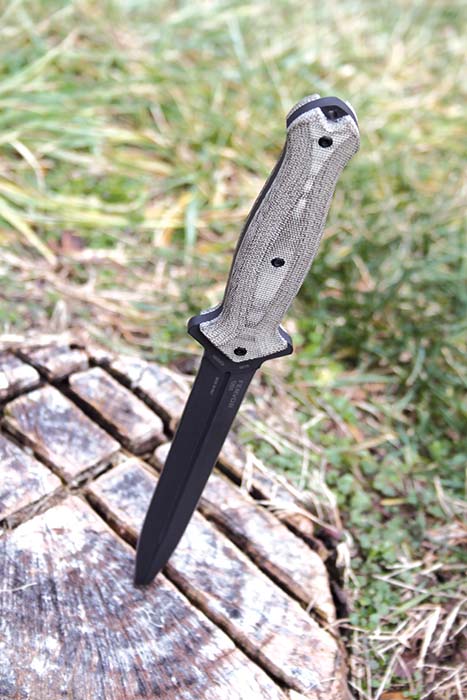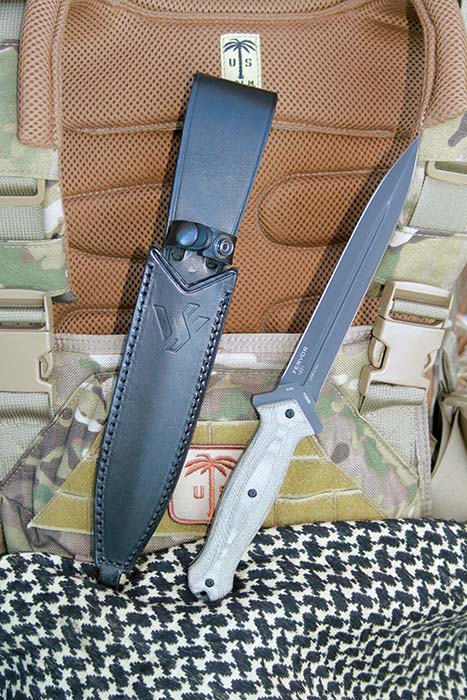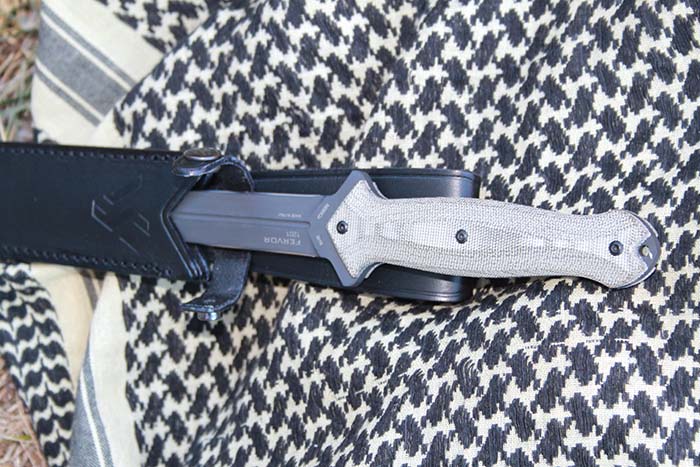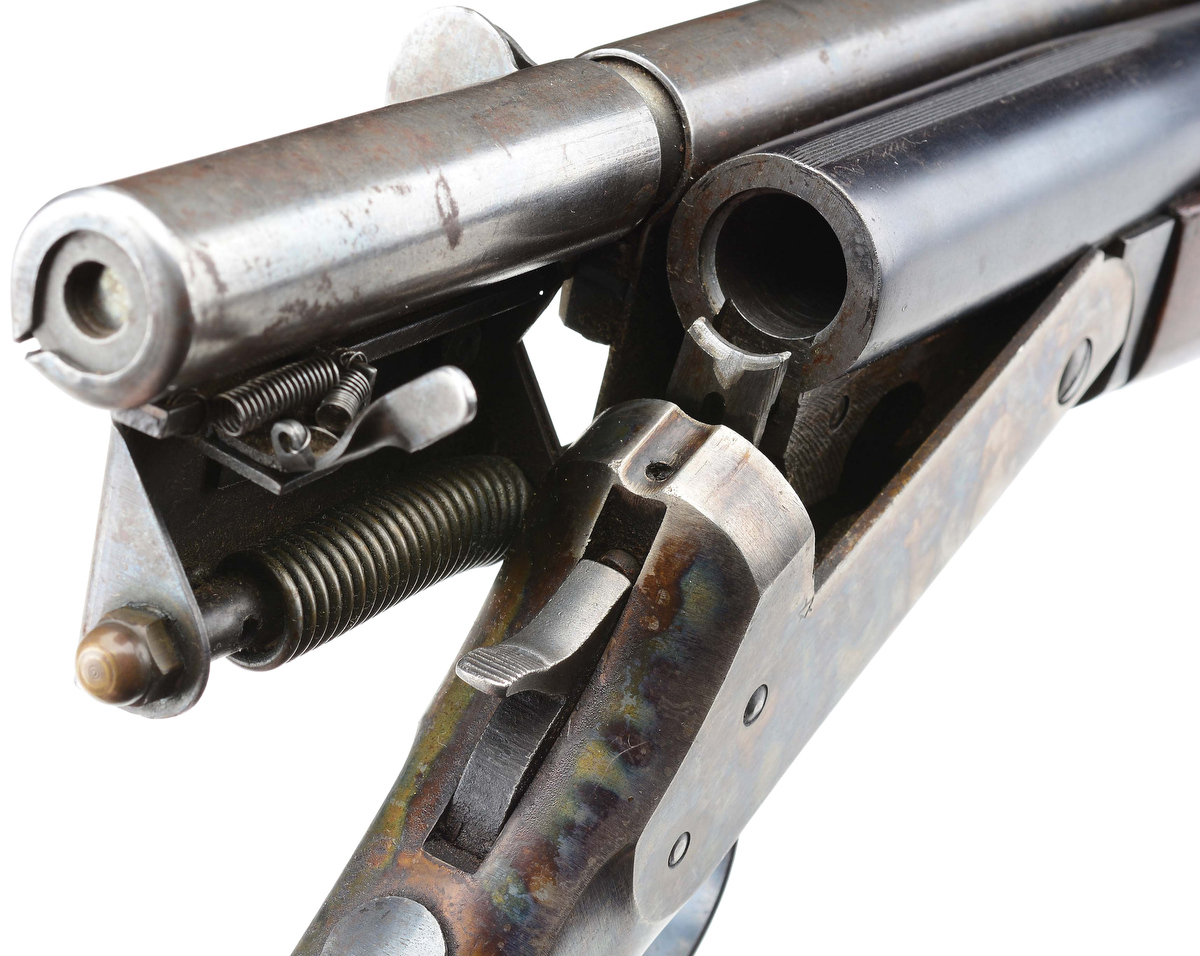The Fervor dagger arrives with a classic leather sheath crafted to provide secure retention.
By Todd Burgreen
Dagger: A fighting implement dating back to the Stone Age and refined ever since.
The dagger dates back to the earliest times of human history. Daggers were initially fashioned out of stone and was subsequently made of every other advancement in material technology that humanity progressed through, up to our modern day steels. There will probably be an energy-based, lightsaber-like dagger once this technology is perfected. The dagger is primarily a thrusting/stabbing weapon. The dagger is and always has been a close-range fighting weapon, not a general purpose tool used for day-to-day chores. This was due to the dagger’s tip being fragile. This fragility was heightened with early specimens fashioned with materials such as flint, obsidian, bone, ivory, etc. that were found around our cave-dwelling ancestors. Such daggers had a relatively flimsy point, limiting any utility as a prying tool, a trait that follows through to today. Sharpened edges running down the sides of the dagger to enhance its prominent point came later in its development and really flourished once bronze, copper, iron and, finally, steel entered the picture. While still a thrusting/penetrating weapon, the double-edged dagger offers the capability to slice or slash an opponent as well. Daggers have often served as ceremonial objects for many societies’ elites dating back to ancient Egypt. Two daggers were found in the tomb of King Tut.
Research for this article indicates that over the last hundred odd years, the dagger’s design has solidified into its current recognizable pattern, including a sharply tapered point, a central spine or fuller, and twin cutting edges sharpened the full length of the blade. Most daggers feature a full crossguard to keep the hand from riding forward onto the sharpened blade edges. The sharpened full-length edges enable the user to make broad slashes using either a forehand or backhand arm movement, while the acutely pointed tip makes the knife an effective thrusting/stabbing weapon. This deadly versatility distinguishes the modern dagger from more specialized thrusting knives, such as the stiletto, which often do not have sharpened edges and rely solely on the point for its work. This brings us to our article focus: the dagger knife as highlighted in the form of the Steel Will Fervor 1201.

Any dagger model that has appeared since WWII must pay homage to the Fairbairn-Sykes (F-S) fighting knife. The F-S is a double-edged dagger fighting knife with a foil grip developed by William Ewart Fairbairn and Eric Anthony Sykes, and it set the bar for dagger design. They based their dagger on lessons learned while advising the Shanghai Municipal Police in China before WWII erupted. The F-S was made famous in WWII by the British Commandos, Airborne Forces and other fighting units. U.S. elite forces such as OSS, Rangers and Marines quickly desired similar profile blades. The length of the F-S (subsequently copied by its successors) was chosen to give several inches of blade to penetrate the body after passing through thick clothing. First production runs of the F-S had a blade length of 6.5 inches with later production runs of the F-S fighting knife extending blade length to 7.5 inches.
Steel Will Knives is a brand under the SMG Inc. (Sport Manufacturing Group, Inc.) banner. SMG is an American company established in 2008. SMG also specializes in the production of pneumatic guns and accessories under the Gletcher brand.
The Steel Will Fervor’s styling harkens back to Medieval times with its appearance. The Fervor is made in Italy to Steel Will’s stringent specifications. Its aesthetics are centered on the sleek 6.69 inch, .22 inch thick double-edged blade created from Austrian N690Co steel, a steel similar to U.S. 440C stainless in terms of corrosion/wear resistance, strength and hardness. The Fervor features a HRC of 58-60. The key with knife steel is the consistency and uniformity in its heat treatment. N690Co is a good choice for hard-use applications and provides increased point strength, something important with a dagger, while allowing for superior edge geometry. A fullered cannelure groove runs does the center of the blade. Created by a tool called a fuller, often referred to as a blood groove, the cannelure is a forging technique that serves to strengthen the Fervor’s blade. A good analogy is to think of the fuller groove serving as an I-beam reinforcement, allowing for strength to be achieved via less material. This translates to penetration power.
The Fervor measures 11.8 inches with its full tang equipped with Micarta grips to interface between user and blade. Those who know how slippery blood and sweat can be will appreciate this attention to detail. The Fervor’s full crossguard further helps to ensure that the user’s hand does not slip past the hilt, which would cause serious injury to the hand. Another distinctive feature of the Fervor is that its handle is designed to give tactile feedback in terms of which way its blade is oriented. The wider, flat area of the handle simulates a horizontal blade and the slimmer, upward facing-handle indicates a vertical blade position. In situations of utter darkness or having to react instantaneously, this intuitive feedback should not be underestimated in importance. For example, using a conventional palm grip with blade horizontal enables the user to slash right or left as well as thrust the blade between an opponent’s ribs. Steel Will uses the ASPIS process black coating finish to further isolate the Fervor’s blade from wear, as well as to reduce glare. The coating is achieved by immersing the steel in oxidant solutions previously heated to its specific temperature. The surface obtained is essentially made of extremely hard oxides that are 0.1 micron thick.
Another distinguishing feature of the Fervor is its Italian leather sheath. Leather has served as a traditional sheath material for good reason. The Fervor’s sheath is fashioned tightly enough to function as a retention means while still allowing for it to be silently drawn. A snap around the handle serves as additional security and is easily unbuckled with either hand. Many times a promising blade is teamed up with a substandard sheath, compromising its potential. This is not the case with the Steel Will Fervor.
The thought process behind daggers like the Steel Will Fervor is to end an engagement with one violent, well-placed thrust. The dagger, when used in correct tactical circumstances, is the knife world’s “sucker punch,” coming from nowhere and deciding the matter quickly and silently. There is a certain primitive purity in the Fervor’s simplicity. Without discounting the benefits of formal martial training, the dagger is made for proactive/aggressive knife fighting. No artistic flourishes or clever knife drills are needed, just aggression, violence and a razor sharp double-edged dagger. Fairbairn and Sykes believed it essential that the dagger blade have a sharp stabbing point and good cutting edges. This was based on the belief that an artery clean cut will not contract as easily as one torn, thus causing the victim to bleed out quicker.

The Steel Will Fervor is not meant for repelling or pushing away; it is meant for thrusting/stabbing. The Fervor is designed to damage as it penetrates. The blade’s geometry enhances its penetration capabilities when stabbing. As the blade enters, it forces apart the medium being penetrated. This allows the knife to pierce effectively, even through heavy clothing. With this said, the slashing/cutting abilities of the Fervor should not be dismissed. If needed in such a role, the Fervor can handle its own against an opponent while still being ready to thrust in an instant.
The Fervor’s ambidextrous handle and double-edged blade facilitates multiple grip types, such as conventional/forward, saber grip or ice pick/reverse grip. Reverse edge methods should not be labeled as only for the unskilled. More and more reverse edge methods are being recognized for efficiency and effectiveness in real world situations. Reverse edge methods are typically more instinctive and natural in use compared to other knife methodologies, thus favoring individuals who are not immersed into a martial art system but are aware of the benefits/advantages of pursuing a certain level of familiarity with knife usage. Each knife grip has advantages and disadvantages. Holding the knife in one of the forward grips allows for more finesse and a longer reach, while a reverse grip allows for more power. The Fervor’s double-edged blade means a user does not have to worry about edge in or edge out orientation as happens with a single-edged weapon.
Anyone interested in further study of reverse edge methods would do well to consult training and literature of James Keating, Gabe Suarez and a trainer going by the name of “Southnarc.” Southnarc is a leading proponent of ice pick/reverse edge. From a background in the Pekiti-tersia branch of Filipino Martial Arts, Southnarc views knife usage through the prism of street reality, based on many years experience as an undercover narcotics officer in a southern U.S. jurisdiction. This type of realistic approach is what most people crave in a training course.
The extreme pointed profile of the dagger blade has always been subject to criticism as being too fragile. In my opinion, this is based on a misunderstanding of the role for which it was designed. The Steel Will Fervor is not a general purpose knife. While the Fervor takes advantage of quality steel to increase its strength, it is not the knife for you if you need a general purpose survival tool. The Fervor’s blade is designed to penetrate objects such as flesh. Testing has shown that the force required to penetrate tissue is directly related to the sharpness/fineness of the tip and overall blade geometry. The sharp tip leading to the straight double edges results in the Fervor penetrating deeply and quickly. It also allows the knife to be removed easily instead of binding up in the target, thus facilitating rapid multiple strikes.
Some will question the voracity of the Steel Will Fervor with its dedicated focus on edged CQB; others will appreciate the simple design methodology that was based on thousands of years of history. Choosing a knife is possibly an even more personal decision than choosing a firearm. A dagger, such as the Fervor, can be viewed in the same way as a combat shotgun, a no-nonsense weapon that is supremely effective in the realm of close-range encounters. There is no doubt that the Fervor would be at home on the web gear or chest rig of anyone with a chance of coming into direct-action contact with a foe. The Fervor represent centuries of refinement for the dedicated combat dagger.
| This article first appeared in Small Arms Review V19N9 (November 2015) |











